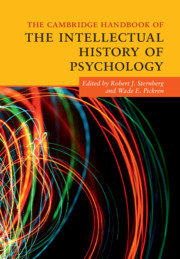Book contents
- The Cambridge Handbook of the Intellectual History of Psychology
- The Cambridge Handbook of the Intellectual History of Psychology
- Copyright page
- Contents
- Figures
- Tables
- Contributors
- Introduction
- 1 Major Paradigms and Approaches in Psychology
- 2 Methodology in Psychology
- 3 Neuroscience in Psychology
- 4 Sensation and Perception
- 5 Attention: Awareness and Control
- 6 Learning
- 7 Memory
- 8 Decision-Making
- 9 Creativity
- 10 Intelligence
- 11 Development
- 12 Social Psychology
- 13 Gender
- 14 Emotion
- 15 Motivation
- 16 Personality
- 17 Abnormal Psychology
- 18 Psychotherapy
- 19 Health Psychology
- Index
- References
17 - Abnormal Psychology
Published online by Cambridge University Press: 18 May 2019
- The Cambridge Handbook of the Intellectual History of Psychology
- The Cambridge Handbook of the Intellectual History of Psychology
- Copyright page
- Contents
- Figures
- Tables
- Contributors
- Introduction
- 1 Major Paradigms and Approaches in Psychology
- 2 Methodology in Psychology
- 3 Neuroscience in Psychology
- 4 Sensation and Perception
- 5 Attention: Awareness and Control
- 6 Learning
- 7 Memory
- 8 Decision-Making
- 9 Creativity
- 10 Intelligence
- 11 Development
- 12 Social Psychology
- 13 Gender
- 14 Emotion
- 15 Motivation
- 16 Personality
- 17 Abnormal Psychology
- 18 Psychotherapy
- 19 Health Psychology
- Index
- References
Summary
During the past 150 years, psychiatrists and psychologists have detected a wide array of mental and behavioural abnormalities in humans, ranging from hysteria, neurosis, and mental deficiency (“feeblemindedness”) to psychopathy, sexual perversions, alcoholism, and criminality. In particular, the differentiation between everyday neuroses and severe mental disorders or psychoses has played an all-important role since the late nineteenth century. In their milder forms, neuroses were deemed equivalent to the common cold, while psychoses were heavily stigmatising and incapacitating mental disturbances. What was common to both neuroses and psychoses was that they indicated an abnormal state of mind. This chapter examines the early phase of the modern history of abnormal psychology in the Western cultural sphere. First, it looks at the idea and term of abnormality and its conceptual relations with “deviance” and “maladjustment.” Then it outlines the early history of the psychopathological studies on abnormality, focusing on key figures such as Pierre Janet, Sigmund Freud, and Carl Gustav Jung. From these pioneers the chapter moves on to examine experimental neuroses and psychopathy, perhaps the most widely known form of maladjustment and abnormality. In conclusion, the most recent trends in abnormal psychology are discussed.
- Type
- Chapter
- Information
- The Cambridge Handbook of the Intellectual History of Psychology , pp. 441 - 467Publisher: Cambridge University PressPrint publication year: 2019



